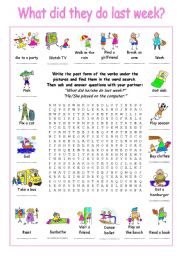
|
What did the do last week? Simple Past 2
Students write the verbs in the past under the pictures, find them in the wordsearch and then ask and answer questions about the pictures, such as "What did he/she do last week?" "He/She played on the computer."
Level: elementary
Age: 10-17
Type: worksheet
Downloads: 117
|
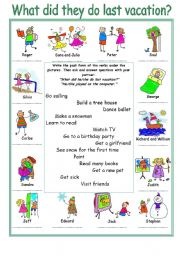
|
What did they do last vacation? Simple Past 1
Students write the verbs in the past under the pictures and then ask and answer questions about the pictures, such as "What did he/she do last vacation?" "He/She played on the computer."
Level: elementary
Age: 10-17
Type: worksheet
Downloads: 126
|
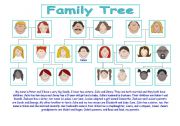
|
Family Tree
Students read the passage and have to complete Peter�s family tree according to the description he makes of his family. It can also be read by the teacher, so students have to listen carefully in order to complete the family tree. If you decide to do that, just erase the text about the family and use the family tree only. Hope it�s useful.
Level: elementary
Age: 10-17
Type: worksheet
Downloads: 85
|
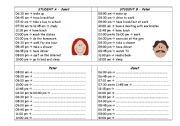
|
Asking about routine
Student A has information about Janet�s schedule and student B has information about Peter�s. They also have a chart (with the time the other character does the activities) to be completed with the activities he/she does during the day. The idea is that one student asks the other "What does Peter/Janet do at ....?", so they can practice third perso...
Level: elementary
Age: 10-17
Type: worksheet
Downloads: 67
|
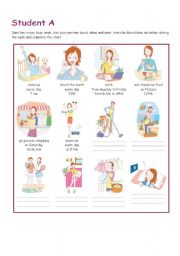
|
Jane has a busy schedule - Simple Present - Oral practice
Students ask each other about Jane�s activities, when and what time she does them. There is a page for student A and a page for student B. The purpose of this exercise is to practice third person singular. Hope it�s useful.
Level: elementary
Age: 10-17
Type: activity-card
Downloads: 93
|
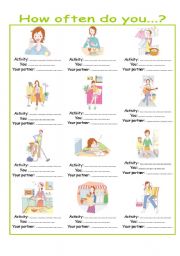
|
How often do you...?
Students should complete the chart with the activity and the frequency they do each activity. Then, they should work in pairs, one asking the other about their routine. Finally, they should report to the rest of the group the frequency his/her partner does each activity. Hope it�s useful.
Level: elementary
Age: 10-17
Type: activity-card
Downloads: 132
|
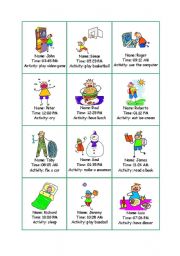
|
What are you doing? - Present Continuous - WS 3
Each student should get a card (there are 12 cards) with a name, time and activity. Then, they should stand up and talk to the other students in order to complete the chart (second page). I put some examples in order to help. Hope it�s useful.
Level: elementary
Age: 10-17
Type: activity-card
Downloads: 217
|
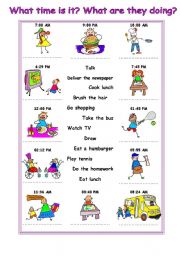
|
What are they doing? - Present Continuous - WS 2
Give students a copy of the exercise and ask them to make the sentences using the verbs given. After that, they can ask each other about the time and the activity the characters are doing.For example: "What is he doing?" --> "He is playing tennis.", "What time is it now?" --> "It�s 3 PM."
Level: elementary
Age: 10-17
Type: worksheet
Downloads: 225
|
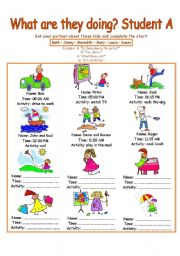
|
What are they doing? - Present Continuous - WS 1
Students ask each other about what the kids in the pictures are doing now and what time it is. There is a page for student A and a page for student B. The students have some names on the top the page and some missing names, time and activities on his sheet. He/she should ask about the people, what they are doing and what time it is.
Level: elementary
Age: 10-17
Type: activity-card
Downloads: 274
|
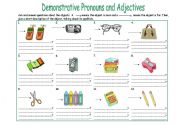
|
Demonstrative Pronouns 2
Second worksheet about demonstrative pronouns. Students should complete the questions and answers first ("What is this? It�s a car. What is it like? It�s fast and big")and then ask his/her partner about the objects and his/her answers.
Level: elementary
Age: 10-17
Type: worksheet
Downloads: 8
|